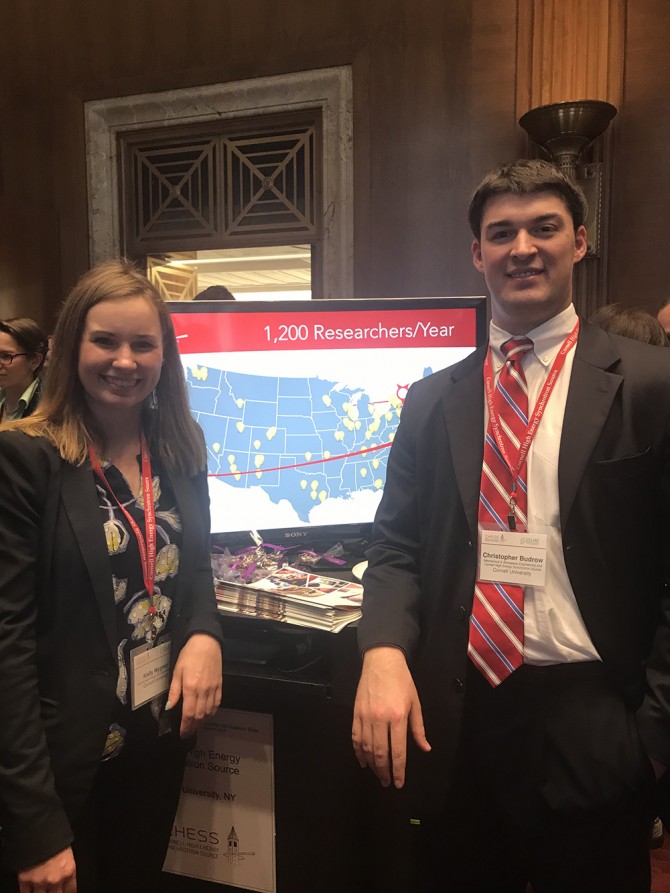CHESS researchers present user facility projects at D.C. expo
By Rachel Rhodes
Researchers from the Cornell High Energy Synchrotron Source (CHESS) showcased Cornell’s X-ray and technical support capabilities in Washington, D.C., April 25 at an exposition hosted by the Society for Science at User Research Facilities (SSURF) and sponsored by the U.S. Senate Energy and Natural Resources Committee. The exposition highlighted projects at 15 national scientific user facilities, including CHESS.
The chairman of SSURF’s board of directors, Paul Runci, opened the exposition by speaking about the importance of user facilities. “I like to think of user facilities as a shared utility toolbox. These facilities, and often combinations of these facilities, contribute to research that will solve the complex problems facing our world today,” he said. “User facilities are a tremendous part of the U.S. innovation ecosystem. We have 15 displays today representing a wide range of disciplines and research, and we want to make sure this work is not a well-kept secret.”
Matt Miller, professor of mechanical and aerospace engineering, led the CHESS team from Cornell and is director of InSitµ@CHESS, a center that provides user support for structural materials analysis using CHESS’s high-energy X-ray beamline. InSitµ specializes in using high-speed diffraction technology to evaluate the structural integrity of materials. Miller, along with postdoctoral associate Kelly Nygren and doctoral student Chris Budrow, presented the results of an InSitµ industry collaboration with Caterpillar, the heavy machinery company.
“When we first partnered with the Office of Naval Research on InSitµ, we looked for industry partners that would be willing to train an employee to use and understand X-ray technology, rather than just allow us to do the work,” Miller said. “Caterpillar sent an employee to work with us, and we were able to run an experiment with him that helped solve a modeling problem by providing a deeper analysis of Caterpillar’s structured metals. Now, the employee we trained has a line out of his door to consult on other projects at Caterpillar.”
Budrow was involved with the Caterpillar collaboration since its inception. “Working with Caterpillar provided a unique experience for me, particularly as the company was supportive of publishing the research documenting our findings,” he said. “But the research eventually has to stop being research and be practical in the real world. We ask, What are the needs of industry? That is the real connection that CHESS can make.”
He added: “It is critical that CHESS’s doors stay open because there are only five user facilities globally that have a high-energy synchrotron. Researchers from all over the world rely on CHESS to push the frontier of using synchrotron light to assess materials, not just Cornell researchers.”
Miller, Nygren and Budrow also met with Rep. Paul Tonko, D-New York, and staff members from the offices of Reps. Cheri Bustos, D-Illinois, Tom Suozzi, D-New York, Jan Schakowksy, D-Illinois, Tom Reed, R-New York, Elise Stefanik, R-New York, and Jose Serrano, D-New York.
Lawmakers should be interested in the work going on at CHESS because of the potential applications to public policy problems, said Nygren. “Metals are one of the first materials humans engineered, but we still have a lot of unanswered questions. We have the tools to overcome the unknown at CHESS and other user facilities, and we can build materials cheaper, lighter and better. The guess-and-check method used to develop traditional materials is costly and inefficient, and we now have the ability to streamline the process to save money and revolutionize the materials we use for our infrastructure.”
Miller said research in structured metals is approaching a watershed moment because of the ability to connect data with practical modeling: “Our current models for material behavior are based on mechanical testing data measured on a larger, or macro, scale. Failure actually occurs on the very smallest of micro scales. Using the high energy X-rays at CHESS, we can now measure the mechanical responses at the micro level. These ‘micromechanical’ data builds trust in the models used by companies like Caterpillar, producing more efficient and safer designs. We need continued federal support so that we can find ways to be accessible to industry partners that may not have the resources to do this work on their own.”
Rachel Rhodes is a public affairs and media relations specialist in Cornell’s Washington, D.C., office.
Media Contact
Get Cornell news delivered right to your inbox.
Subscribe

